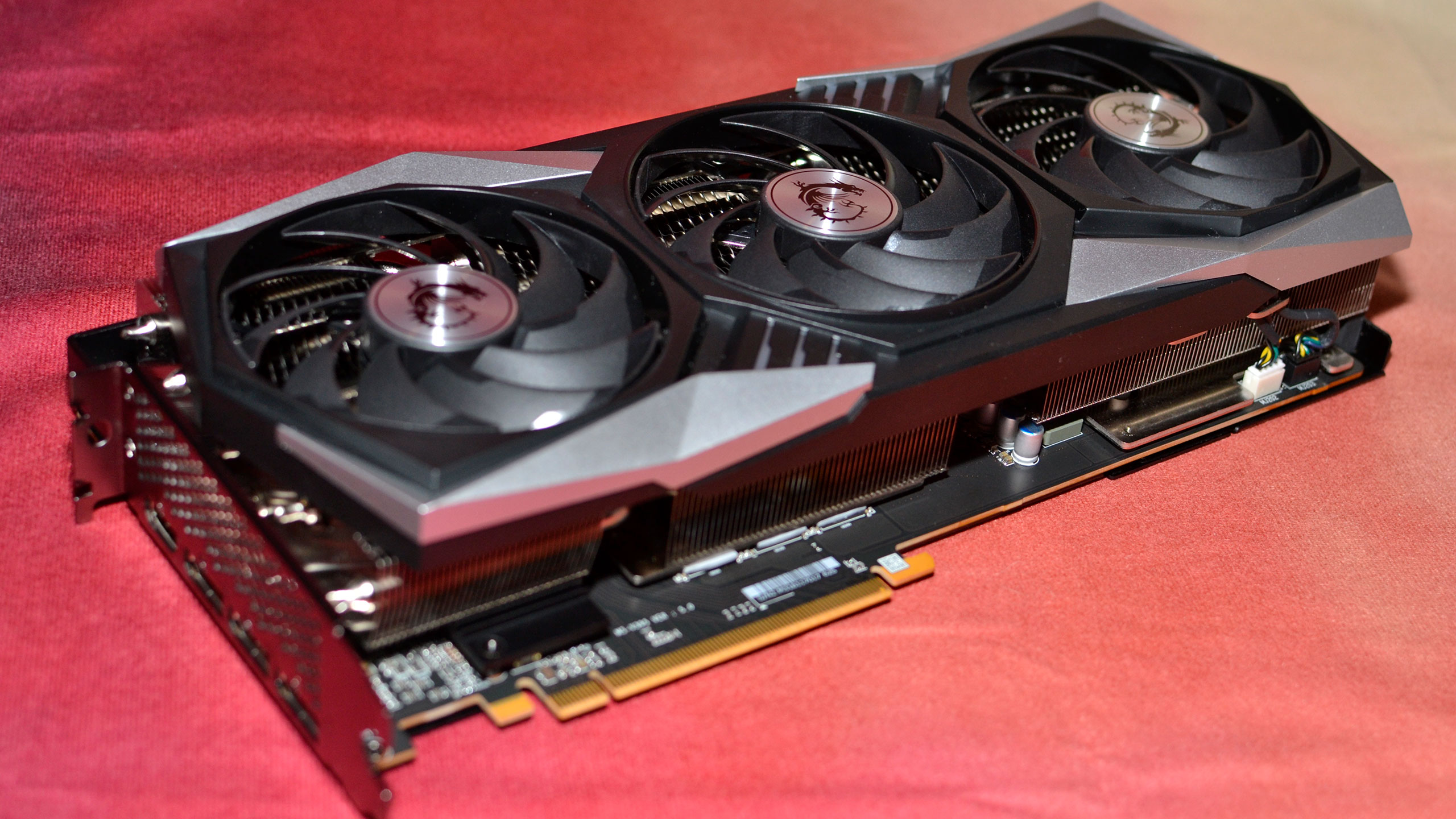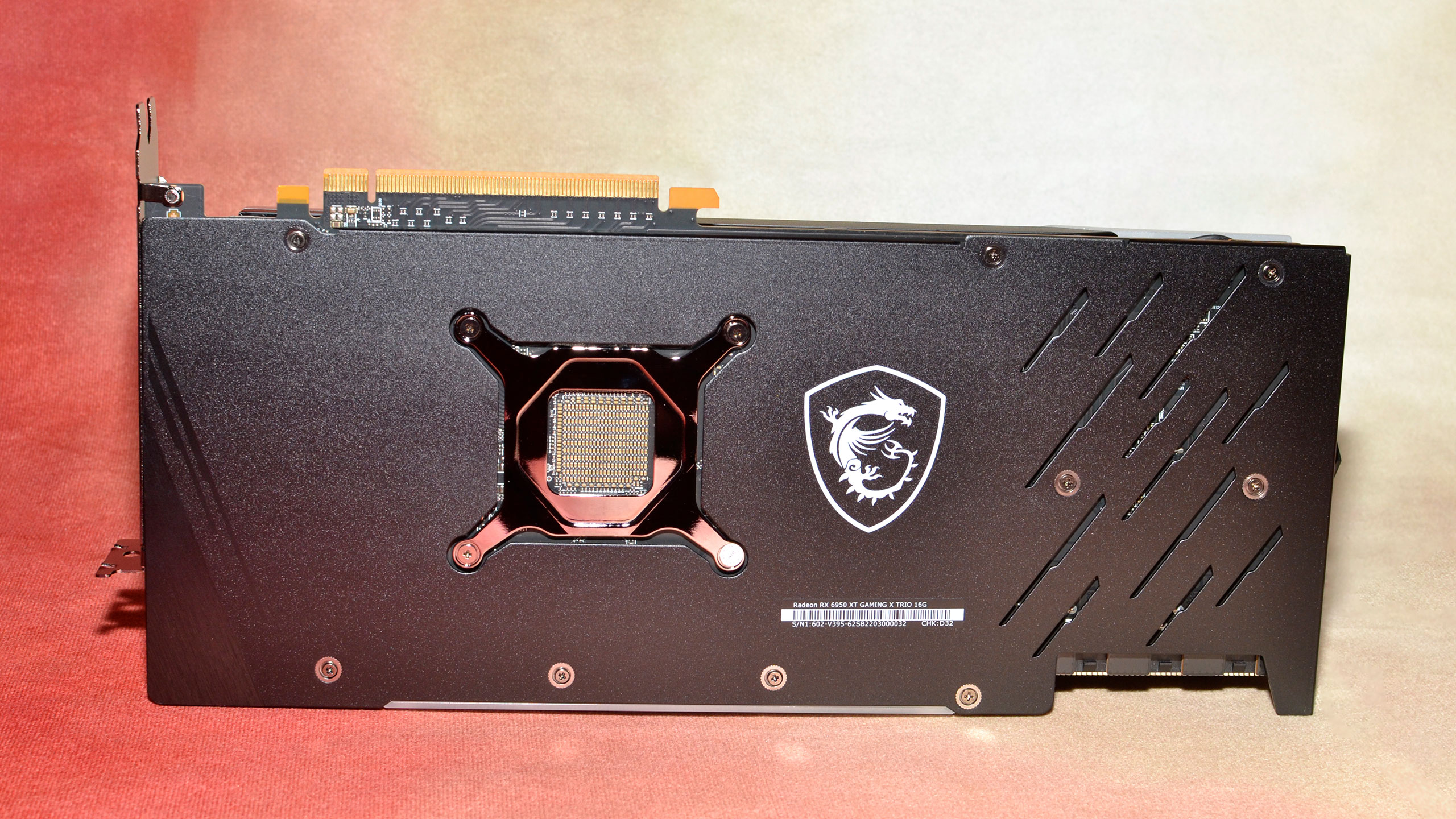Why you can trust Tom's Hardware

Without a new architecture, there's only so much AMD's RX 6950 XT can do to take on its Nvidia rivals. AMD has proven it knows how to get GPUs running at much higher clocks with RDNA 2, and RDNA 3 might be the first consumer GPU to break 3 GHz if the current trend continues. That would be pretty awesome, even if it uses a lot of power. But in the here and now, Navi 21 can lay claim to the 1080p and 1440p standard gaming performance thrones while falling behind at 4K and trailing with a large deficit in ray tracing performance.
The problem is that MSI's top-tier variant of the RX 6950 XT pushes power use far higher than its rival, without any real gains in performance. Frankly, it's flabbergasting that Sapphire can use the same GPU and effectively match MSI's performance while using 70W less power. We're not sure if the credit goes to some great engineering on the Nitro+ Pure, or poor engineering on the MSI Gaming X Trio, but if you have a choice between these two cards, Sapphire walks away with an easy victory.
Sapphire's card looks better (in my opinion), runs just as fast, and uses less power. And if you don't want to go with the Sapphire card for whatever reason, there are multiple other Radeon RX 6950 XT options that basically can't be worse than this MSI model. Okay, maybe they have 100 MHz lower boost clocks, but for $200 less, that's a far more sensible choice.

That's assuming you even want to go with an RX 6950 XT, of course. If you're not looking for the top performing AMD GPU right now, the RX 6900 XT is only about 6% slower and can be found for as little as $800, with several other models going for $900. There's also the RX 6800 XT, which is supposed to start at $650 but currently costs nearly as much as the least expensive 6900 XT. For the same price as the RX 6900 XT, you can also pick up a GeForce RTX 3080 12GB, and while it might fall behind in some games, the superior ray tracing hardware and DLSS support certainly makes that a good alternative. Even the formerly overpriced RTX 3080 Ti is worth a look, starting at under $1,100.
AMD does try to sweeten the pot a bit with some gaming extras, via its current Raise the Game Bundle, which you won't get from Nvidia. If you buy an RX 6950 XT (or any GPU from the RX 6700 XT and up), from a participating retailer, you'll get codes for the Saints Row reboot, Sniper Elite 5, and Forspoken (when it comes out). Game bundles aren't the same as buying games at retail, though, since you don't get a choice and AMD pays a lot less per game than the retail price — call it a $50 add-in if you want. That's fine, but for a GPU that costs over a grand, it's not some amazing offer.
We should see AMD's next generation architecture launch within a few months, so even with GPUs now on shelves at better prices than we've seen in two years, we still recommend waiting. If you simply have to buy a new graphics card right now, we suggest you pick up something for closer to $300 like the Radeon RX 6600 that can tide you over until RDNA 3 and Ada Lovelace arrive, rather than purchasing an extreme GPU that will invariably feel outdated and slow before 2022 wraps up.
Regardless, MSI's inefficient take on the RX 6950 XT just doesn't make a lot of sense. If it used 15% more power and provided at least a 5% boost to performance, it would be easier to recommend. Using 15% more power for the same performance, though? No thanks. More power means more heat in your case, which impacts noise levels and your PC in general. Even if you're using your PC as a space heater while gaming, we'd still prefer a card that uses less power and delivers the same performance.
- MORE: Best Graphics Cards
- MORE: GPU Benchmarks and Hierarchy
- MORE: All Graphics Content
Current page: Bottom Line: MSI Radeon RX 6950 XT
Prev Page MSI Radeon RX 6950 XT: Power, Temps, Noise, Etc.Jarred Walton is a senior editor at Tom's Hardware focusing on everything GPU. He has been working as a tech journalist since 2004, writing for AnandTech, Maximum PC, and PC Gamer. From the first S3 Virge '3D decelerators' to today's GPUs, Jarred keeps up with all the latest graphics trends and is the one to ask about game performance.
-
-Fran- What a terrible model... The Sapphire is way way better, like always. MSI didn't even try to make this card decent; more like just fulfilling commitments or quotas.Reply
Also, I wonder if toying around with the VRAM speed would yield better results than the core in terms of extra FPS'es and specially power for the 6950XT. I have the 6900XT and I know for sure it does, but it's capped at ~2000, since it starts artifacting heavily above that speed for me. I run it stock, but I wanted to test the limit of it, heh.
Regards. -
King_V Editing nipick:Reply
We are not showing professional application performance with the MSI card, as it was basically the same story as we saw with our initial MSI RX 6950 XT content creation results.
That MSI that's linked should say Sapphire.
Still, given how little benefit pushing the extreme limits of power consumption gave to MSI, I'm really curious about how much, or rather, little, performance might be lost in backing down the power and clocks... I know nobody buys a top-of-the-line card in order to be power-efficient, but I wonder if we might have a situation here that is similar to the underclocking runs for the Vega 56. -
JarredWaltonGPU Reply
I poked around a bit at VRAM speeds when I was doing the Sapphire review. Ultimately, I didn't say much about it, but even though you can push clocks higher, I don't think you get the gains that I'd expect. There's something goofy with the VRAM speeds on these 18Gbps modules where you often don't get anywhere near the theoretical boost in performance relative to the existing 16Gbps cards. I suspect memory timings (which you can't directly see on the GDDR6) are somehow at play.-Fran- said:What a terrible model... The Sapphire is way way better, like always. MSI didn't even try to make this card decent; more like just fulfilling commitments or quotas.
Also, I wonder if toying around with the VRAM speed would yield better results than the core in terms of extra FPS'es and specially power for the 6950XT. I have the 6900XT and I know for sure it does, but it's capped at ~2000, since it starts artifacting heavily above that speed for me. I run it stock, but I wanted to test the limit of it, heh.
Regards.
For example, and I know this is a specific use case, but the cryptocurrency mining speed of the RX 6950 XT was consistently far lower than the RX 6900 XT, regardless of what I tried. You can get ~65 MH/s out of the RX 6900 XT after tuning, but the best I ever managed on the RX 6950 XT was about 54 MH/s. "Stock" (factory) performance with a tweak to the maximum GPU clock did better than any attempted memory overclock. -
-Fran- Reply
That is so weirdly interesting... I wonder if the higher clocks were at the expense of way way looser timings?JarredWaltonGPU said:I poked around a bit at VRAM speeds when I was doing the Sapphire review. Ultimately, I didn't say much about it, but even though you can push clocks higher, I don't think you get the gains that I'd expect. There's something goofy with the VRAM speeds on these 18Gbps modules where you often don't get anywhere near the theoretical boost in performance relative to the existing 16Gbps cards. I suspect memory timings (which you can't directly see on the GDDR6) are somehow at play.
For example, and I know this is a specific use case, but the cryptocurrency mining speed of the RX 6950 XT was consistently far lower than the RX 6900 XT, regardless of what I tried. You can get ~65 MH/s out of the RX 6900 XT after tuning, but the best I ever managed on the RX 6950 XT was about 54 MH/s. "Stock" (factory) performance with a tweak to the maximum GPU clock did better than any attempted memory overclock.
Regards. -
Sleepy_Hollowed Wow, what on earth is this card for? Expensive, inefficient space heater?Reply
Since even messing with voltages does not seem to make performance better, this is an absolute head scratcher, probably a spec-hunter card only.
That being said, other versions of this card will get some real usage with AMD's FSR 2.0 and it will make absolute sense even with zero tensor cores. Losing ~7 frames per second to nvidia is neglible at those resolutions and with comparable quality as well.
Let's see if next gen and DLSS 3.0 might be different, but DLSS 2.x is not.
